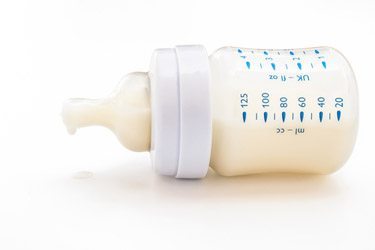Breast May Be Best, But Buying Breast Milk on the Internet Is Risky, Says Study
Some women who are unable to breastfeed turn to the Internet to buy breast milk from others who produce more than they need. While this may seem like a good use of modern technology to share a scarce and important resource, new research suggests it could be dangerous.

Some women who are unable to breastfeed their infants because of adoption, lack of production, medical issues, or other reasons turn to the Internet to buy breast milk from others who produce more than they need. While this may seem like a good use of modern technology to share a scarce and important resource, new research suggests it could be dangerous. A study published this week in the Journal of Pediatrics found that much of the breast milk purchased or exchanged online contained potentially harmful bacteria.
Researchers from Nationwide Children’s Hospital in Columbus, Ohio, found over 13,000 websites offering to sell or exchange breast milk when they began their study in 2011. They bought samples from 100 of these sites and compared them to samples from a nonprofit breast milk bank, USA Today reported. There are 12 of these banks in the United States, and they follow strict guidelines set by the Human Milk Banking Association of North America. Not only do these banks carefully screen donors, they pasteurize the milk before shipping it out to infants, which kills harmful bacteria. Milk purchased or exchanged on the Internet is not pasteurized. (For the purposes of the study, however, the milk from the milk bank was provided to the researchers without being pasteurized so that it could be more fairly compared to the unpasteurized milk purchased via the Internet.)
The study found big differences in the two sets of milk. Specifically, it found that 72 percent of the milk purchased online had detectable levels of gram-negative bacteria (which are associated with bloodstream infections, wound infections, meningitis, and fecal contamination), compared to 35 percent of milk bank samples; 63 percent of the Internet samples tested positive for staph infections, compared to 25 percent of milk bank samples; 36 percent of the Internet samples tested positive for strep infections, compared to 20 percent of the milk bank samples; and 3 percent of the Internet samples were contaminated with salmonella, compared to none of the milk bank samples. Though HIV can be transmitted through breast milk, that virus was not found in any of the samples.
Dr. Sarah Keim, the study’s lead author, told the New York Times, “Most staph and strep are harmless at normal levels. But some of the levels we found were very high.” She added that salmonella “doesn’t belong in milk at all.” Keim believes that the high level of bacteria is most likely caused by poor hygiene in the collection process (women who don’t wash their hands and/or don’t adequately wash the breast pump) as well as improper shipping techniques. For example, 19 percent of Internet sellers did not include dry ice or another cooling mechanism when they shipped the milk.
Keim and her team also questioned the authenticity of some of the samples they got. She told the New York Times, “Buyers have no way of knowing even what they’re getting—it could be cow’s milk or formula.”
Though milk banks are safer, pasteurization can also destroy some of the substances that make breast milk beneficial to babies. Moreover, milk banks tend to reserve their supply for premature infants with medical issues and will only provide it with a prescription. If there is extra supply, they may give it to a healthy infant with a prescription, but there is rarely such a surplus, and the milk is expensive at about $6 per ounce. (Remember that a one-month-old drinks about 25 ounces per day.)
Kim Updegrove, president of the milk bank association, says she understands why some women turn to the Internet given these prohibitions. She told the New York Times, “I hate to say this to an informal sharer, because they are trying to do good. But they are playing a game of Russian roulette.” Her comments to the Philadelphia Inquirer were even stronger. “Human milk is a body fluid, so it contains all the bacteria and viruses that are in the mom’s body at the time the milk is expressed,” she said. “It’s no different than blood. Would you go to your neighbor and ask for a pint of blood?”
Some people, however, believe that the practice of sharing breast milk through informal networks of neighbors and friends or even online is an important way to spread the benefits of breastfeeding to more infants. They say that the study focused on most risky method of sharing breast milk—having it shipped from anonymous people who are selling it online. Shell Walker, a midwife in Phoenix, started a site called Eats on Feets, through which women share milk in person. (Her site does not allow women to sell the milk, because that opens up ethical and safety questions.) She called the study “sensational and flawed.”
Still, most experts agree that sharing breast milk is too risky. The Food and Drug Administration discourages both online and person-to-person sharing, and the American Academy of Pediatrics discourages feeding preterm infants breast milk from unscreened donors.
Updegrove believes that women are better off turning to the supermarket shelf than the Internet: “My advice would be to use formula. These children are just too precious.”
